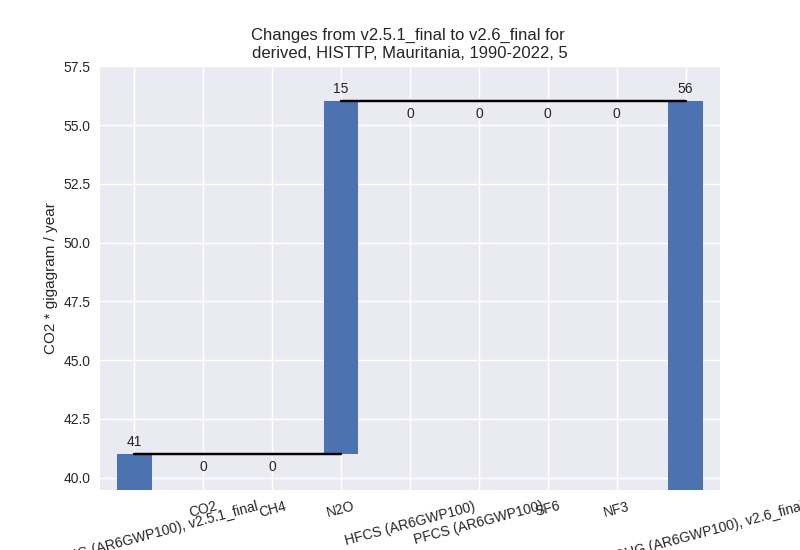Changes in PRIMAP-hist v2.6_final compared to v2.5.1_final for Mauritania
2024-09-24
Johannes Gütschow
Change analysis for Mauritania for PRIMAP-hist v2.6_final compared to v2.5.1_final
Overview over emissions by sector and gas
The following figures show the aggregate national total emissions excluding LULUCF AR6GWP100 for the country reported priority scenario. The dotted linesshow the v2.5.1_final data.
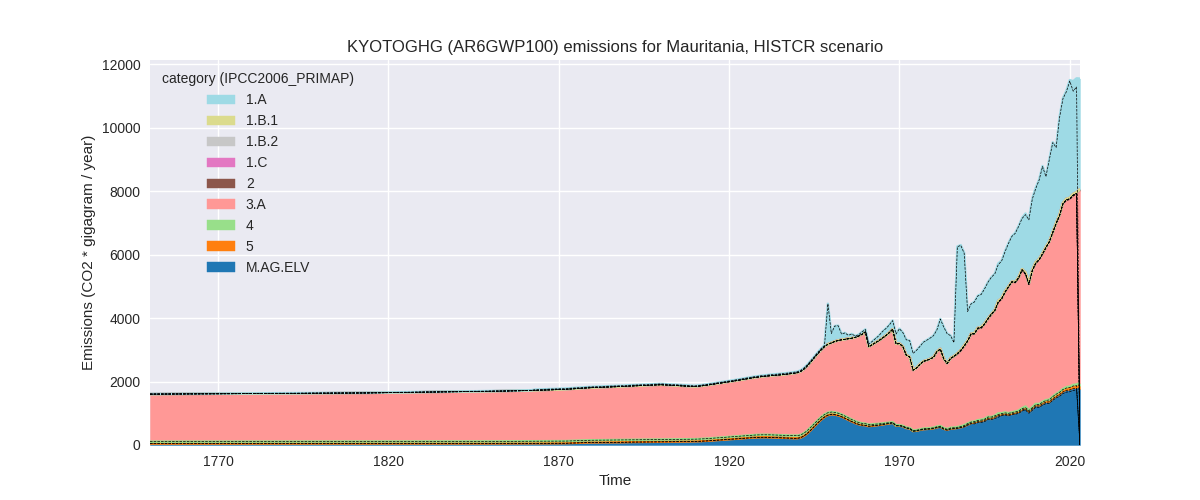
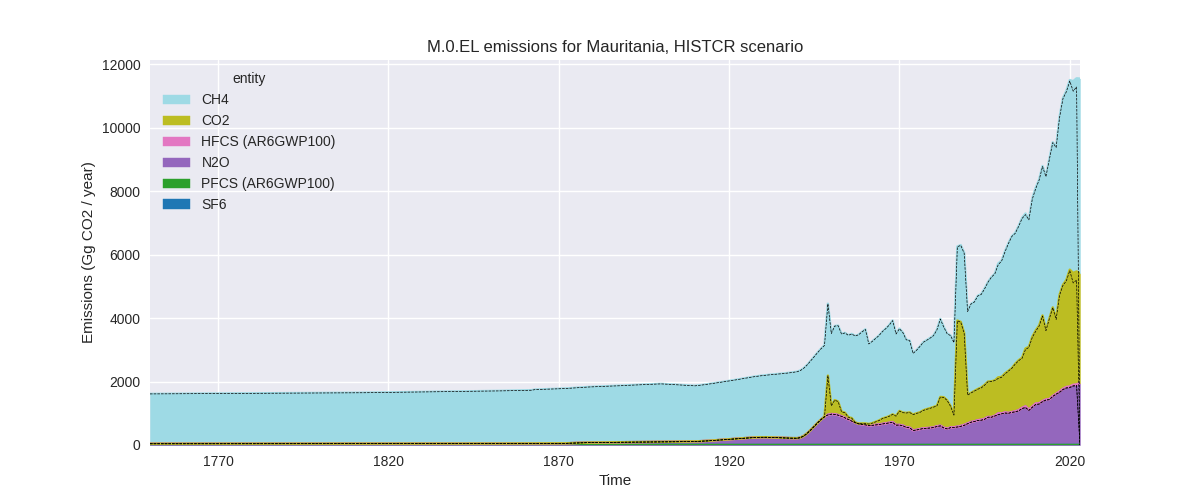
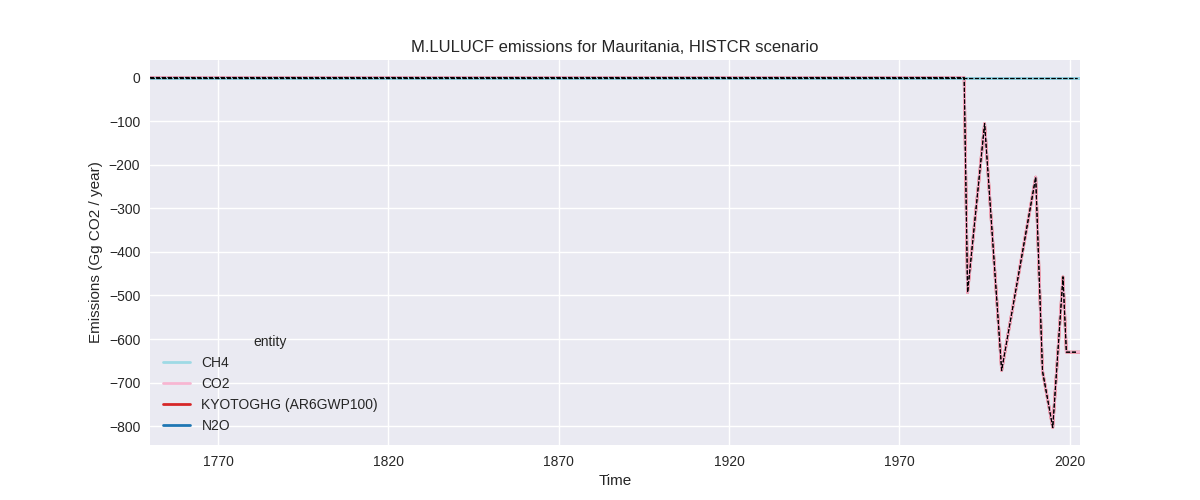
The following figures show the aggregate national total emissions excluding LULUCF AR6GWP100 for the third party priority scenario. The dotted linesshow the v2.5.1_final data.
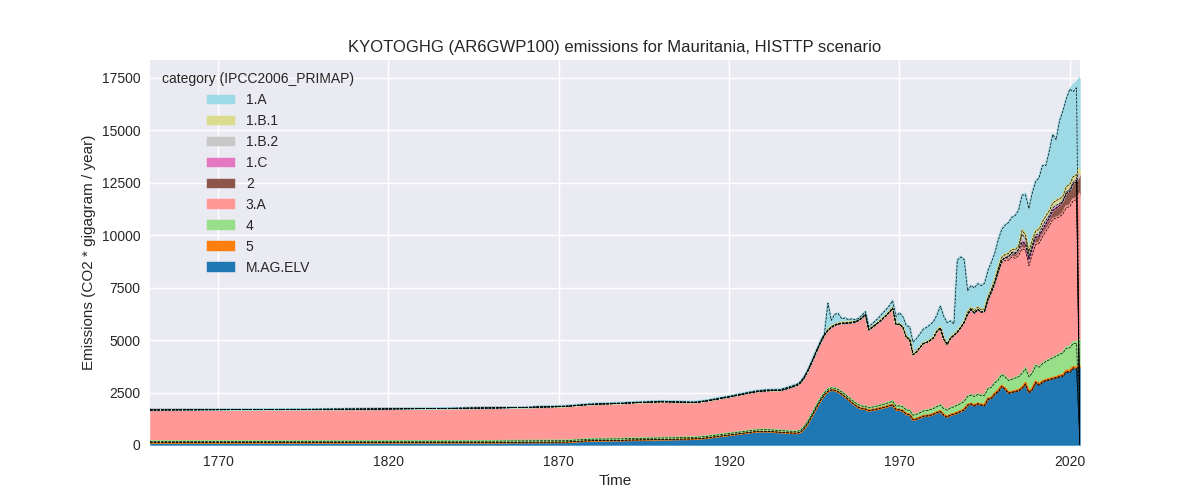
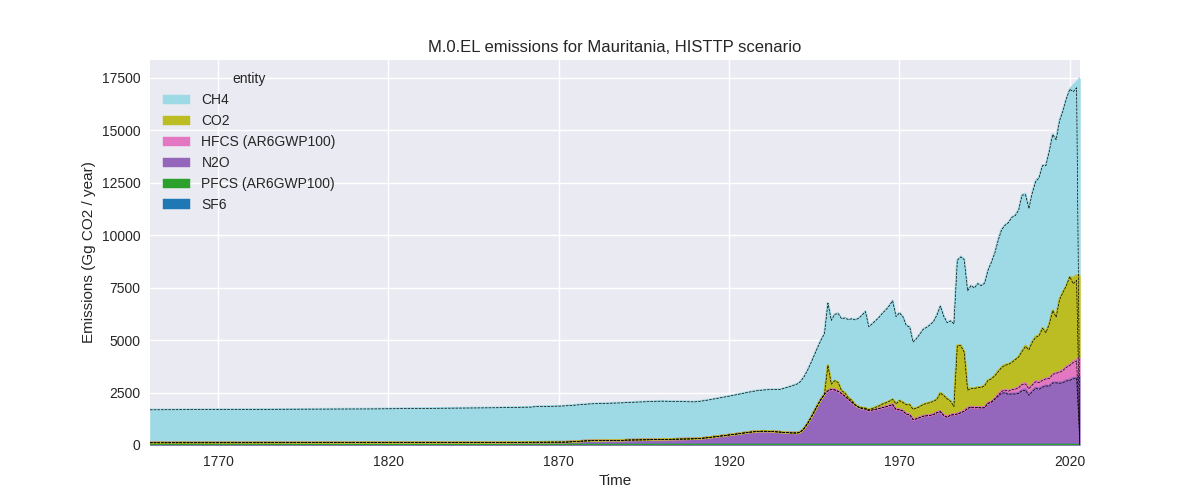
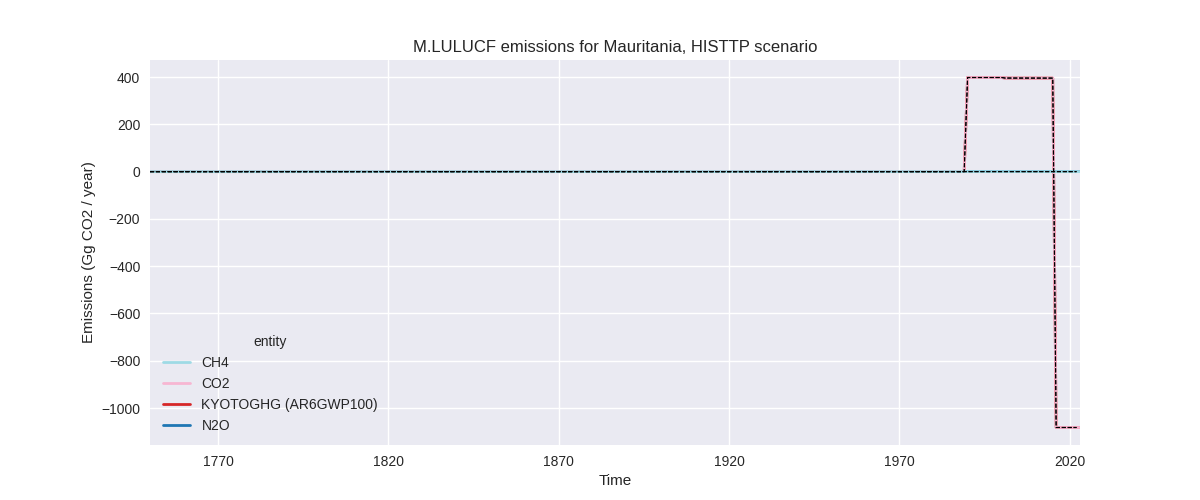
Overview over changes
In the country reported priority scenario we have the following changes for aggregate Kyoto GHG and national total emissions excluding LULUCF (M.0.EL):
- Emissions in 2022 have changed by 2.4%% (270.79 Gg CO2 / year)
- Emissions in 1990-2022 have changed by 0.4%% (31.27 Gg CO2 / year)
In the third party priority scenario we have the following changes for aggregate Kyoto GHG and national total emissions excluding LULUCF (M.0.EL):
- Emissions in 2022 have changed by 1.5%% (249.41 Gg CO2 / year)
- Emissions in 1990-2022 have changed by 0.2%% (26.38 Gg CO2 / year)
Most important changes per scenario and time frame
In the country reported priority scenario the following sector-gas combinations have the highest absolute impact on national total KyotoGHG (AR6GWP100) emissions in 2022 (top 5):
- 1: 1.A, CO2 with 234.00 Gg CO2 / year (7.1%)
- 2: 5, N2O with 29.71 Gg CO2 / year (49.5%)
- 3: 4, CO2 with 4.53 Gg CO2 / year (30.6%)
- 4: M.AG.ELV, CO2 with 2.38 Gg CO2 / year (22.9%)
- 5: 2, CO2 with 1.96 Gg CO2 / year (17.1%)
In the country reported priority scenario the following sector-gas combinations have the highest absolute impact on national total KyotoGHG (AR6GWP100) emissions in 1990-2022 (top 5):
- 1: 1.A, CO2 with 15.55 Gg CO2 / year (0.8%)
- 2: 5, N2O with 15.01 Gg CO2 / year (36.6%)
- 3: 4, CO2 with 0.53 Gg CO2 / year (7.7%)
- 4: 2, CO2 with 0.23 Gg CO2 / year (1.6%)
- 5: M.AG.ELV, CO2 with 0.23 Gg CO2 / year (4.1%)
In the third party priority scenario the following sector-gas combinations have the highest absolute impact on national total KyotoGHG (AR6GWP100) emissions in 2022 (top 5):
- 1: 1.A, CO2 with 264.94 Gg CO2 / year (7.1%)
- 2: 1.B.2, CO2 with -78.87 Gg CO2 / year (-100.0%)
- 3: 5, N2O with 29.71 Gg CO2 / year (49.5%)
- 4: 4, CH4 with 14.11 Gg CO2 / year (1.3%)
- 5: 2, HFCS (AR6GWP100) with 12.20 Gg CO2 / year (1.5%)
In the third party priority scenario the following sector-gas combinations have the highest absolute impact on national total KyotoGHG (AR6GWP100) emissions in 1990-2022 (top 5):
- 1: 1.A, CO2 with 17.60 Gg CO2 / year (0.9%)
- 2: 5, N2O with 15.01 Gg CO2 / year (36.6%)
- 3: 1.B.2, CO2 with -8.54 Gg CO2 / year (-21.1%)
- 4: 4, CH4 with 1.04 Gg CO2 / year (0.2%)
- 5: 4, CO2 with 0.54 Gg CO2 / year (7.9%)
Notes on data changes
Here we list notes explaining important emissions changes for the country. ’' means that the following text only applies to the TP time series, while means that it only applies to the CR scenario. Otherwise the note applies to both scenarios.
- We have no new country reported data for Mauritania
- Higher energy CO2 emissions in 2021 and 2022 are from updated EI data (CR, TP)
- Some 2022 changes come from the shorted trend period for numerical extrapolation.
- For CO2 in 1.B.2 the change in extrapolation also affects cumulative emissions. the effect on the TP time-series is higher as EDGAR data is much higher than country reported data.
- Changes in sectors 4 and 5 are due to the removal of FAOSTAT data.
- Small changes for f-gases because the GWP used was stated incorrectly in BUR2 and has been fixed.
Changes by sector and gas
For each scenario and time frame the changes are displayed for all individual sectors and all individual gases. In the sector plot we use aggregate Kyoto GHGs in AR6GWP100. In the gas plot we usenational total emissions without LULUCF. ## country reported scenario
2022
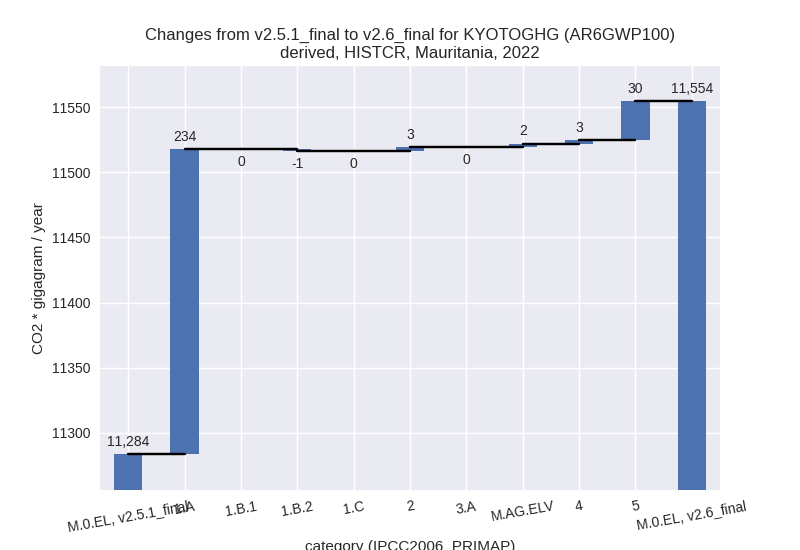
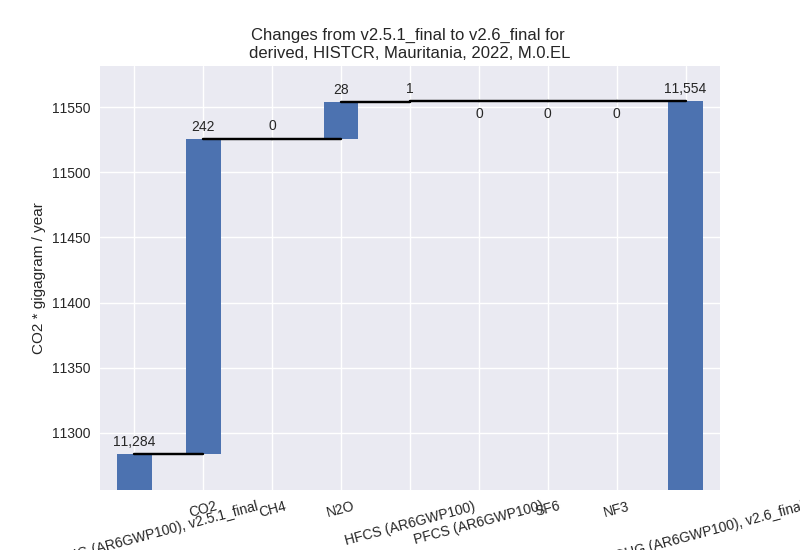
1990-2022

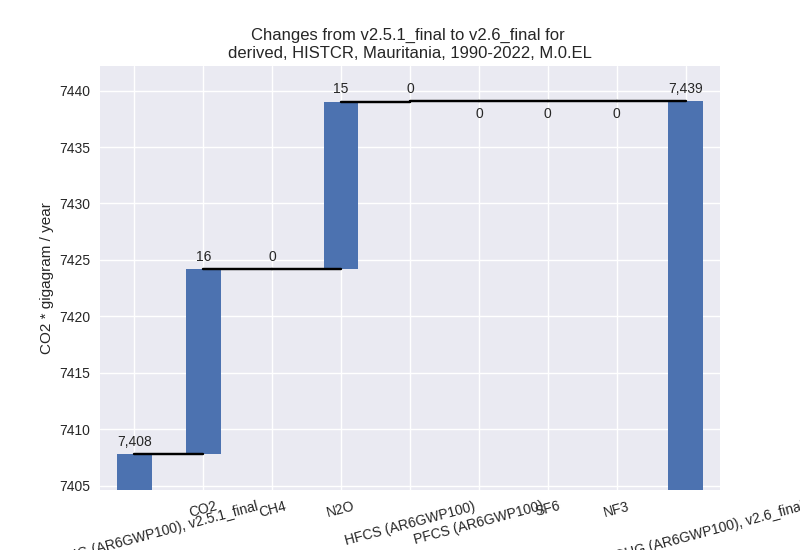
third party scenario
2022
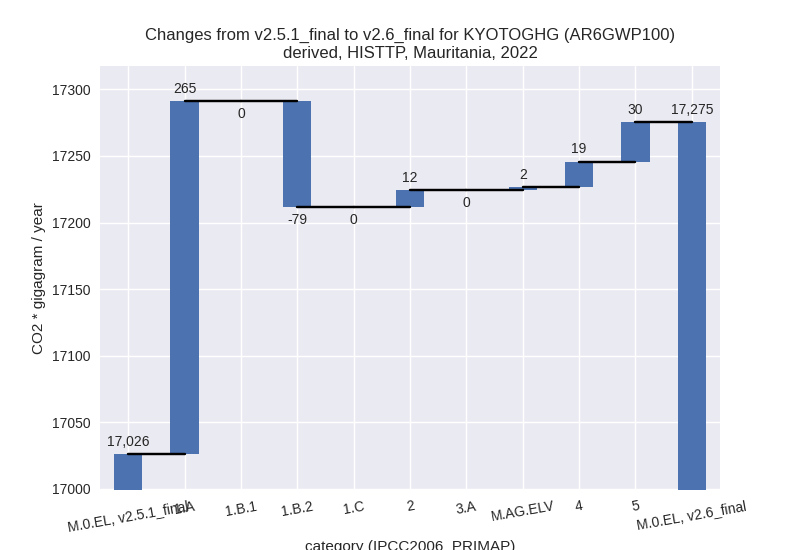
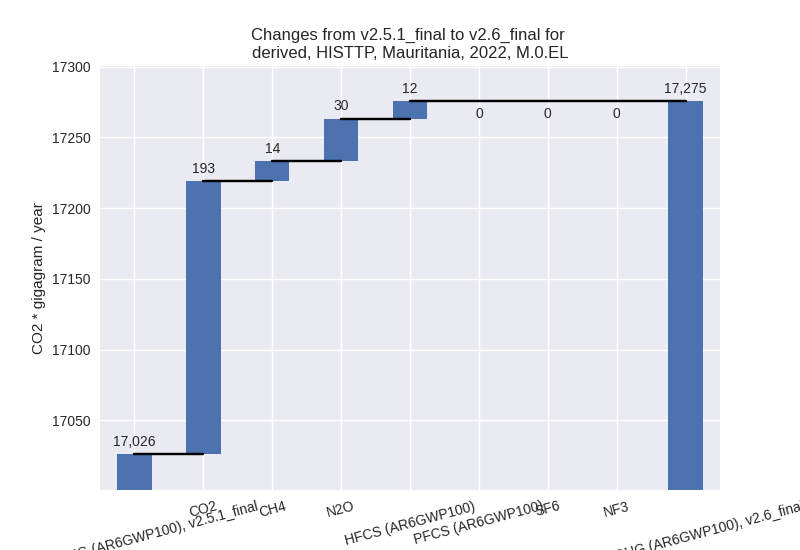
1990-2022
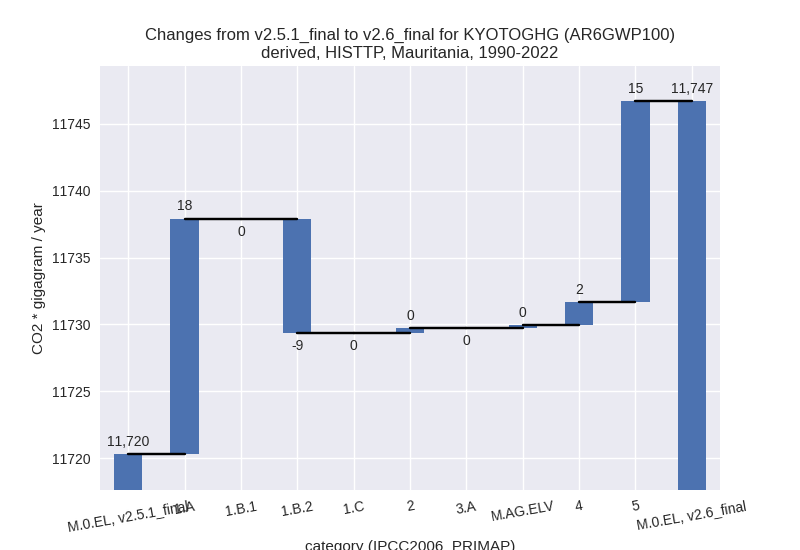
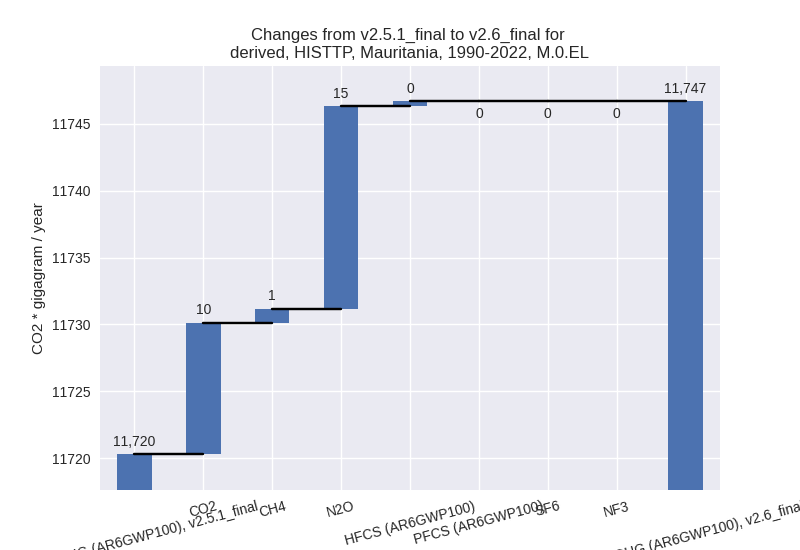
Detailed changes for the scenarios:
country reported scenario (HISTCR):
Most important changes per time frame
For 2022 the following sector-gas combinations have the highest absolute impact on national total KyotoGHG (AR6GWP100) emissions in 2022 (top 5):
- 1: 1.A, CO2 with 234.00 Gg CO2 / year (7.1%)
- 2: 5, N2O with 29.71 Gg CO2 / year (49.5%)
- 3: 4, CO2 with 4.53 Gg CO2 / year (30.6%)
- 4: M.AG.ELV, CO2 with 2.38 Gg CO2 / year (22.9%)
- 5: 2, CO2 with 1.96 Gg CO2 / year (17.1%)
For 1990-2022 the following sector-gas combinations have the highest absolute impact on national total KyotoGHG (AR6GWP100) emissions in 1990-2022 (top 5):
- 1: 1.A, CO2 with 15.55 Gg CO2 / year (0.8%)
- 2: 5, N2O with 15.01 Gg CO2 / year (36.6%)
- 3: 4, CO2 with 0.53 Gg CO2 / year (7.7%)
- 4: 2, CO2 with 0.23 Gg CO2 / year (1.6%)
- 5: M.AG.ELV, CO2 with 0.23 Gg CO2 / year (4.1%)
Changes in the main sectors for aggregate KyotoGHG (AR6GWP100) are
- 1: Total sectoral emissions in 2022 are 3587.94 Gg
CO2 / year which is 31.1% of M.0.EL emissions. 2022 Emissions have
changed by 6.9% (232.96 Gg CO2 /
year). 1990-2022 Emissions have changed by 0.8% (15.41 Gg CO2 / year). For 2022 the
changes per gas
are:

The changes come from the following subsectors:- 1.A: Total sectoral emissions in 2022 are 3587.94
Gg CO2 / year which is 100.0% of category 1 emissions. 2022 Emissions
have changed by 7.0% (234.00 Gg CO2
/ year). 1990-2022 Emissions have changed by 0.8% (15.55 Gg CO2 / year). For 2022 the
changes per gas
are:
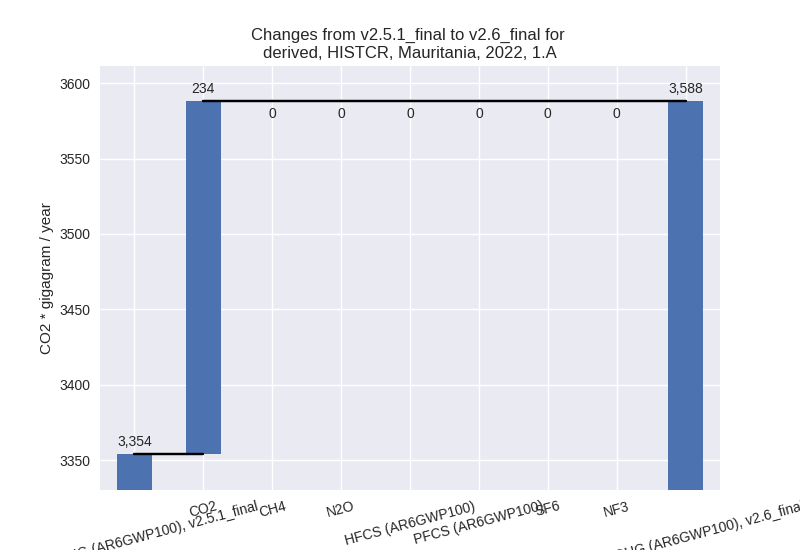
There is no subsector information available in PRIMAP-hist. - 1.B.2: Total sectoral emissions in 2022 are 0.00 Gg
CO2 / year which is 0.0% of category 1 emissions. 2022 Emissions have
changed by -100.0% (-1.04 Gg CO2 /
year). 1990-2022 Emissions have changed by -13.7% (-0.14 Gg CO2 / year). For 2022 the
changes per gas
are:
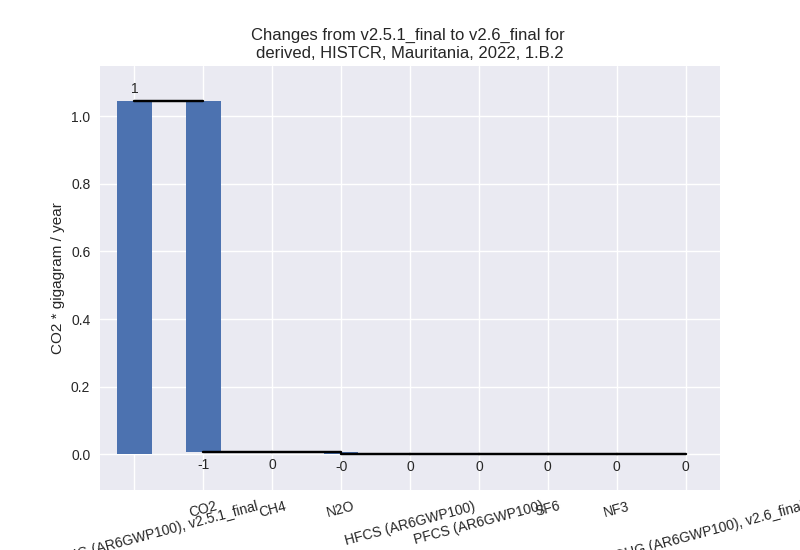
For 1990-2022 the changes per gas are: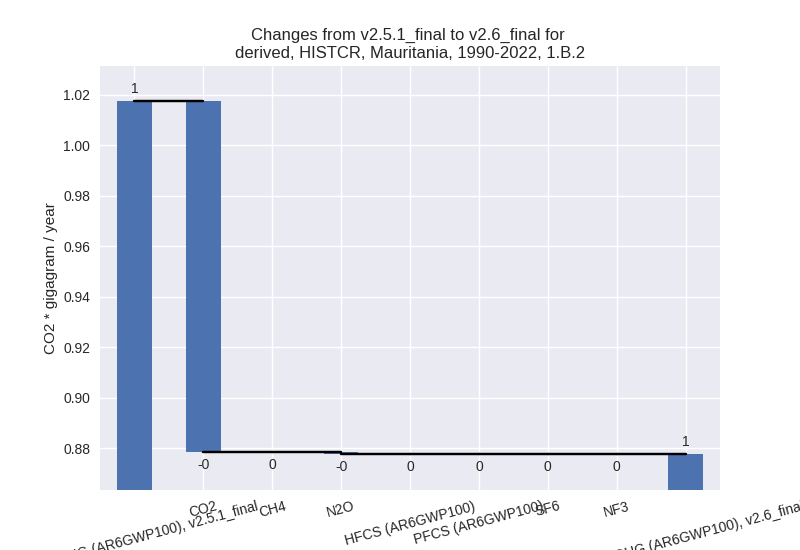
There is no subsector information available in PRIMAP-hist.
- 1.A: Total sectoral emissions in 2022 are 3587.94
Gg CO2 / year which is 100.0% of category 1 emissions. 2022 Emissions
have changed by 7.0% (234.00 Gg CO2
/ year). 1990-2022 Emissions have changed by 0.8% (15.55 Gg CO2 / year). For 2022 the
changes per gas
are:
- 2: Total sectoral emissions in 2022 are 29.22 Gg
CO2 / year which is 0.3% of M.0.EL emissions. 2022 Emissions have
changed by 10.5% (2.77 Gg CO2 /
year). 1990-2022 Emissions have changed by 1.3% (0.26 Gg CO2 / year). For 2022 the
changes per gas
are:
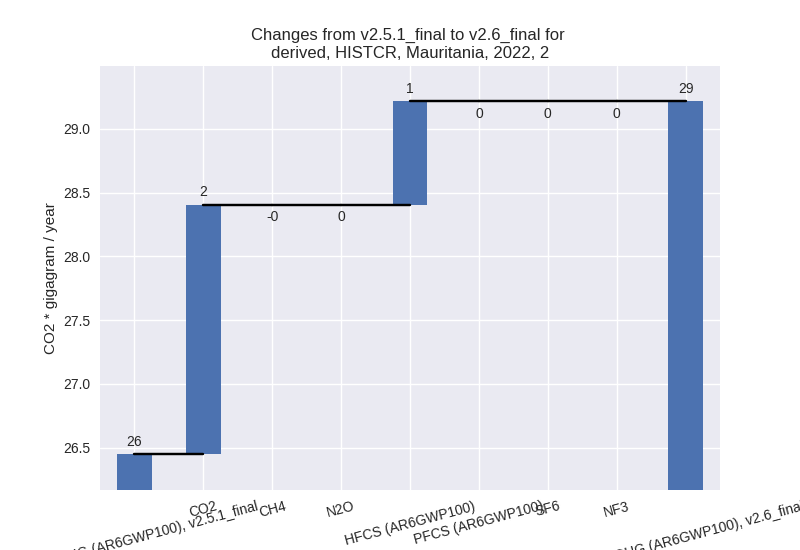
- M.AG: Total sectoral emissions in 2022 are 7764.15 Gg CO2 / year which is 67.2% of M.0.EL emissions. 2022 Emissions have changed by 0.0% (2.38 Gg CO2 / year). 1990-2022 Emissions have changed by 0.0% (0.23 Gg CO2 / year).
- 4: Total sectoral emissions in 2022 are 83.41 Gg
CO2 / year which is 0.7% of M.0.EL emissions. 2022 Emissions have
changed by 3.7% (2.98 Gg CO2 /
year). 1990-2022 Emissions have changed by 0.7% (0.36 Gg CO2 / year). For 2022 the
changes per gas
are:

- 5: Total sectoral emissions in 2022 are 89.75 Gg
CO2 / year which is 0.8% of M.0.EL emissions. 2022 Emissions have
changed by 49.5% (29.71 Gg CO2 /
year). 1990-2022 Emissions have changed by 36.6% (15.01 Gg CO2 / year). For 2022 the
changes per gas
are:
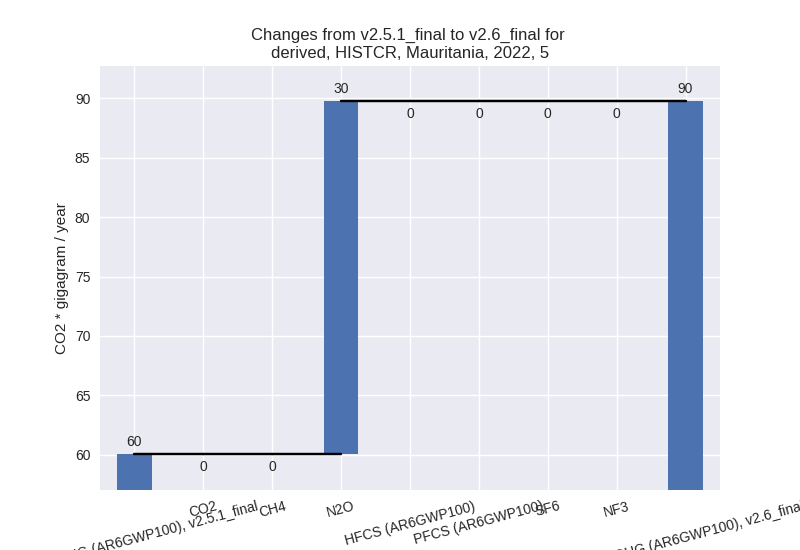
For 1990-2022 the changes per gas are: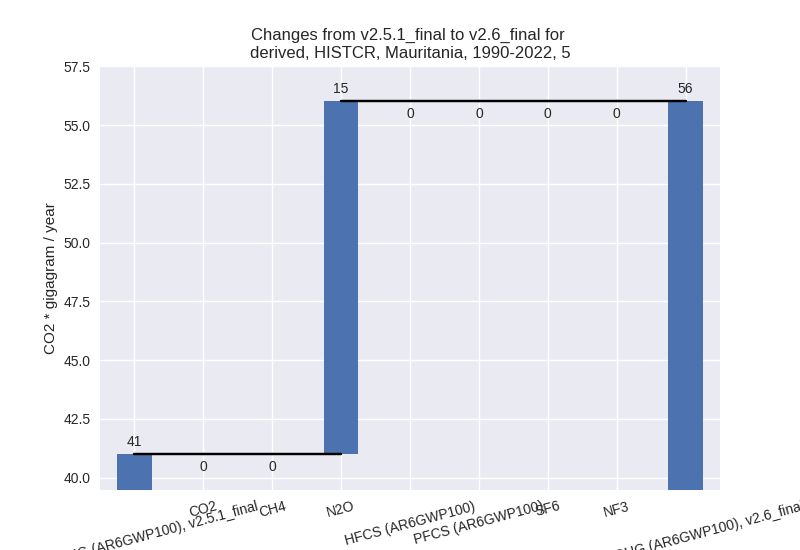
third party scenario (HISTTP):
Most important changes per time frame
For 2022 the following sector-gas combinations have the highest absolute impact on national total KyotoGHG (AR6GWP100) emissions in 2022 (top 5):
- 1: 1.A, CO2 with 264.94 Gg CO2 / year (7.1%)
- 2: 1.B.2, CO2 with -78.87 Gg CO2 / year (-100.0%)
- 3: 5, N2O with 29.71 Gg CO2 / year (49.5%)
- 4: 4, CH4 with 14.11 Gg CO2 / year (1.3%)
- 5: 2, HFCS (AR6GWP100) with 12.20 Gg CO2 / year (1.5%)
For 1990-2022 the following sector-gas combinations have the highest absolute impact on national total KyotoGHG (AR6GWP100) emissions in 1990-2022 (top 5):
- 1: 1.A, CO2 with 17.60 Gg CO2 / year (0.9%)
- 2: 5, N2O with 15.01 Gg CO2 / year (36.6%)
- 3: 1.B.2, CO2 with -8.54 Gg CO2 / year (-21.1%)
- 4: 4, CH4 with 1.04 Gg CO2 / year (0.2%)
- 5: 4, CO2 with 0.54 Gg CO2 / year (7.9%)
Changes in the main sectors for aggregate KyotoGHG (AR6GWP100) are
- 1: Total sectoral emissions in 2022 are 4665.18 Gg
CO2 / year which is 27.0% of M.0.EL emissions. 2022 Emissions have
changed by 4.1% (185.84 Gg CO2 /
year). 1990-2022 Emissions have changed by 0.4% (9.04 Gg CO2 / year). For 2022 the
changes per gas
are:
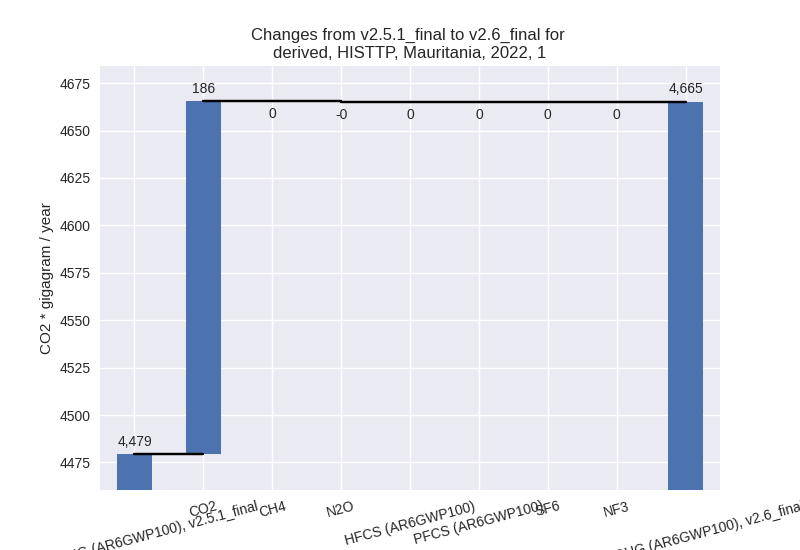
The changes come from the following subsectors:- 1.A: Total sectoral emissions in 2022 are 4406.08
Gg CO2 / year which is 94.4% of category 1 emissions. 2022 Emissions
have changed by 6.4% (264.94 Gg CO2
/ year). 1990-2022 Emissions have changed by 0.8% (17.60 Gg CO2 / year). For 2022 the
changes per gas
are:
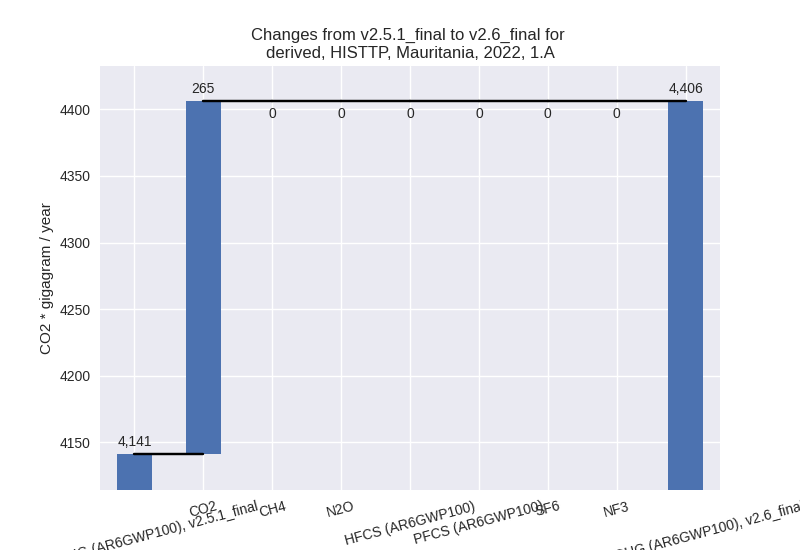
There is no subsector information available in PRIMAP-hist. - 1.B.1: Total sectoral emissions in 2022 are 259.10 Gg CO2 / year which is 5.6% of category 1 emissions. 2022 Emissions have changed by 0.0% (0.00 Gg CO2 / year). 1990-2022 Emissions have changed by 0.0% (0.00 Gg CO2 / year).
- 1.B.2: Total sectoral emissions in 2022 are 0.00 Gg
CO2 / year which is 0.0% of category 1 emissions. 2022 Emissions have
changed by -100.0% (-79.10 Gg CO2 /
year). 1990-2022 Emissions have changed by -12.4% (-8.56 Gg CO2 / year). For 2022 the
changes per gas
are:

For 1990-2022 the changes per gas are: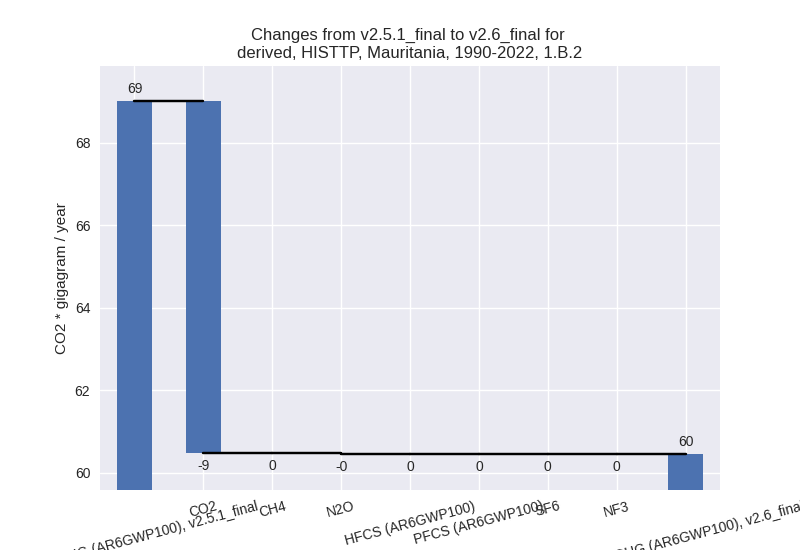
There is no subsector information available in PRIMAP-hist.
- 1.A: Total sectoral emissions in 2022 are 4406.08
Gg CO2 / year which is 94.4% of category 1 emissions. 2022 Emissions
have changed by 6.4% (264.94 Gg CO2
/ year). 1990-2022 Emissions have changed by 0.8% (17.60 Gg CO2 / year). For 2022 the
changes per gas
are:
- 2: Total sectoral emissions in 2022 are 866.81 Gg CO2 / year which is 5.0% of M.0.EL emissions. 2022 Emissions have changed by 1.4% (12.21 Gg CO2 / year). 1990-2022 Emissions have changed by 0.1% (0.37 Gg CO2 / year).
- M.AG: Total sectoral emissions in 2022 are 10441.64 Gg CO2 / year which is 60.4% of M.0.EL emissions. 2022 Emissions have changed by 0.0% (2.38 Gg CO2 / year). 1990-2022 Emissions have changed by 0.0% (0.23 Gg CO2 / year).
- 4: Total sectoral emissions in 2022 are 1212.10 Gg CO2 / year which is 7.0% of M.0.EL emissions. 2022 Emissions have changed by 1.6% (19.28 Gg CO2 / year). 1990-2022 Emissions have changed by 0.2% (1.73 Gg CO2 / year).
- 5: Total sectoral emissions in 2022 are 89.75 Gg
CO2 / year which is 0.5% of M.0.EL emissions. 2022 Emissions have
changed by 49.5% (29.71 Gg CO2 /
year). 1990-2022 Emissions have changed by 36.6% (15.01 Gg CO2 / year). For 2022 the
changes per gas
are:
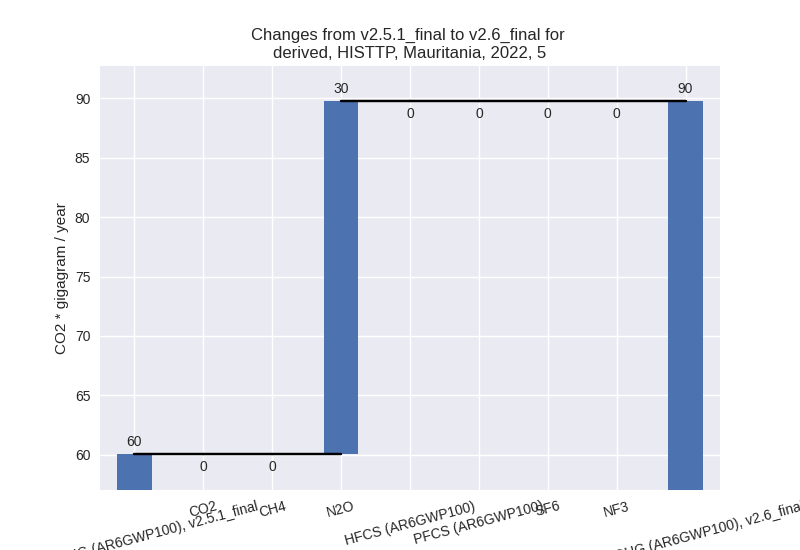
For 1990-2022 the changes per gas are: